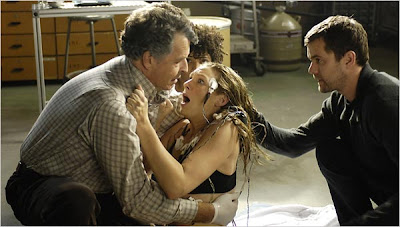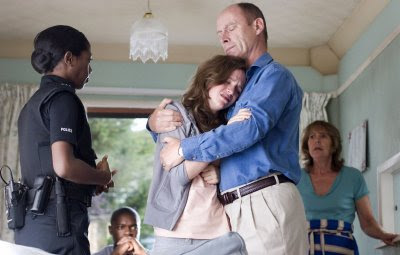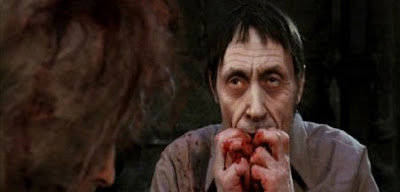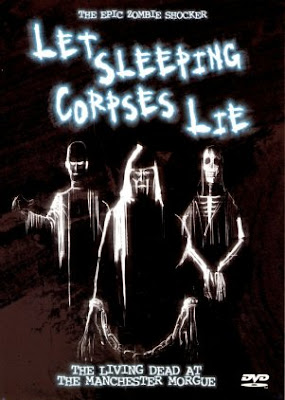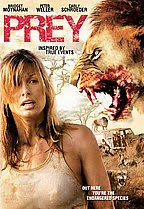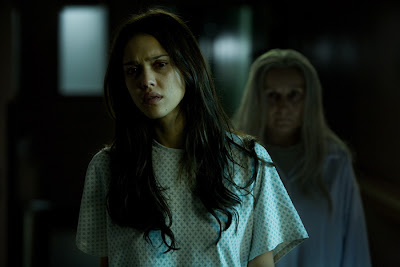
Brad: Vince Vaughn
Kate: Reese Witherspoon
Marilyn: Mary Steenburgen
Howard: Robert Duvall
Dallas: Jon Favreau
Paula: Sissy Spacek
Courtney: Kristin Chenoweth
Pastor Phil: Dwight Yoakam
Dallas: Tim McGraw
Creighton: Jon Voight
New Line Cinema presents a film directed by Seth Gordon. Written by Matt R. Allen & Caleb Wilson and Jon Lucas & Scott Moore. Running time: 82 min. Rated PG-13 (for some sexual humor and language).
One of the things I like best about movies is the way certain ones can just hit you with a lesson about life. Usually they are lessons you already know, often ones that have been stated in hundreds of other similar movies. But it takes a certain combination of laughs and people and pacing, and suddenly it hits you just right. In the new holiday-themed romantic comedy “Four Christmases”, there is a moment where I said to myself, “That is one of those truths about love that we all overlook too often.”
You often hear people talking about what they want out of a relationship. I want this or that. But a relationship isn’t about what you want; it is about what you are willing to give. No, that isn’t incredibly profound, but if we kept it in the front of our minds when in a relationship, would we talk about what we want out of it? “Four Christmases” makes this point very clearly through its simplicity, and along the way it offers some good laughs.
That being said, this movie doesn’t break any new ground beyond not staying beyond its welcome. At a brisk 82 minute running time, “Four Christmases” takes us through the typical holiday relationship torture test of seeing two beautiful people suffer through the trials of visiting the (cue ominous descending chords) In-Laws. Its particular take on the subject involves Brad and Kate. As played by Vince Vaughn (“Fred Claus”) and Reese Witherspoon (“Rendition”), they are a modern couple with an honest, open relationship. They seem to take pleasure in bucking traditional relationship values at the embarrassment of other couples, but they are true and in love with each other. Vaughn and Witherspoon make a surprisingly good couple.
Brad and Kate each come from divorced parents, which informs their choice to remain unmarried. They actively avoid their families during the holidays, claiming to be involved in charity work whilst actually spending their vacation on vacation, much to the chagrin of co-workers condemned to the family obligations. But when a thick fog grounds all of the San Francisco Airport flights and an ambitious news reporter put Brad and Kate on television to capture their disappointment in missing their flight to Fiji, the jig is up. They now are forced to visit his dad, her mom, his mom and her dad in one day, so they can still make their delayed vacation.
Director Seth Gordon (“The King of Kong: A Fistful of Quarters”) pulls out all the stops in the casting of the couples’ strange parents. Robert Duvall, Mary Steenburgen, Sissy Spacek, and Jon Voight play the respective parents, each but Voight threatening to steal every scene they’re in.
They kick off their holiday fun with Brad’s whiskey tango father (Duvall, “We Own the Night”) and his “ultimate fighting” brothers Dallas (Tim McGraw, “Friday Night Lights”) and Denver (Jon Favreau, “Iron Man”). Kate learns some secrets about Brad, such as the fact that each boy was named after the city in which they were conceived. Brad’s real name is Orlando. Then it is off to Kate’s cougar mother’s house, and there perhaps is no better cougar out there than Mary Steenburgen (“Step Brothers”). We meet her new age preacher boyfriend (Dwight Yoakam, “Crank”) and Brad learns some of Kate’s skeletons.
Trips to the final two parents’ houses don’t reveal much new story-wise but do provide some good laughs, like the fact that Brad’s mom (Spacek, “Hot Rod”) is now dating one of his former best friends who doesn’t “want to replace (his) father,” he just wants “to be a friend.” Kate’s dad (Voight, “National Treasure”) comes in right on cue to provide a voice of reason.
That sinking feeling came to my stomach when it became clear the couple was going to hit that inevitable rough patch because of all they had learned about each other and their families during that trying day. But then instead of an extended sequence of the couple being mean to each other and pretending to feel ways they didn’t, as is standard for such formula, the characters remain honest with one another and that revelation about love I mentioned earlier comes over the audience and characters at once.
Despite refusing to torture the audience by drawing out things unnecessarily, this movie is all formula and only the truly conditioned will like it. Brad and Kate do go through some rather obvious introspection about themselves and how they feel about each other. But I liked the movie’s frankness with its subject matter. Nor do the filmmakers ask you to like people who really aren’t very nice. “Four Christmases” may seem like a holiday trial to some audiences, but for simple laughs and not even an hour and a half of your time, it has its moments.
Kate: Reese Witherspoon
Marilyn: Mary Steenburgen
Howard: Robert Duvall
Dallas: Jon Favreau
Paula: Sissy Spacek
Courtney: Kristin Chenoweth
Pastor Phil: Dwight Yoakam
Dallas: Tim McGraw
Creighton: Jon Voight
New Line Cinema presents a film directed by Seth Gordon. Written by Matt R. Allen & Caleb Wilson and Jon Lucas & Scott Moore. Running time: 82 min. Rated PG-13 (for some sexual humor and language).
One of the things I like best about movies is the way certain ones can just hit you with a lesson about life. Usually they are lessons you already know, often ones that have been stated in hundreds of other similar movies. But it takes a certain combination of laughs and people and pacing, and suddenly it hits you just right. In the new holiday-themed romantic comedy “Four Christmases”, there is a moment where I said to myself, “That is one of those truths about love that we all overlook too often.”
You often hear people talking about what they want out of a relationship. I want this or that. But a relationship isn’t about what you want; it is about what you are willing to give. No, that isn’t incredibly profound, but if we kept it in the front of our minds when in a relationship, would we talk about what we want out of it? “Four Christmases” makes this point very clearly through its simplicity, and along the way it offers some good laughs.
That being said, this movie doesn’t break any new ground beyond not staying beyond its welcome. At a brisk 82 minute running time, “Four Christmases” takes us through the typical holiday relationship torture test of seeing two beautiful people suffer through the trials of visiting the (cue ominous descending chords) In-Laws. Its particular take on the subject involves Brad and Kate. As played by Vince Vaughn (“Fred Claus”) and Reese Witherspoon (“Rendition”), they are a modern couple with an honest, open relationship. They seem to take pleasure in bucking traditional relationship values at the embarrassment of other couples, but they are true and in love with each other. Vaughn and Witherspoon make a surprisingly good couple.
Brad and Kate each come from divorced parents, which informs their choice to remain unmarried. They actively avoid their families during the holidays, claiming to be involved in charity work whilst actually spending their vacation on vacation, much to the chagrin of co-workers condemned to the family obligations. But when a thick fog grounds all of the San Francisco Airport flights and an ambitious news reporter put Brad and Kate on television to capture their disappointment in missing their flight to Fiji, the jig is up. They now are forced to visit his dad, her mom, his mom and her dad in one day, so they can still make their delayed vacation.
Director Seth Gordon (“The King of Kong: A Fistful of Quarters”) pulls out all the stops in the casting of the couples’ strange parents. Robert Duvall, Mary Steenburgen, Sissy Spacek, and Jon Voight play the respective parents, each but Voight threatening to steal every scene they’re in.
They kick off their holiday fun with Brad’s whiskey tango father (Duvall, “We Own the Night”) and his “ultimate fighting” brothers Dallas (Tim McGraw, “Friday Night Lights”) and Denver (Jon Favreau, “Iron Man”). Kate learns some secrets about Brad, such as the fact that each boy was named after the city in which they were conceived. Brad’s real name is Orlando. Then it is off to Kate’s cougar mother’s house, and there perhaps is no better cougar out there than Mary Steenburgen (“Step Brothers”). We meet her new age preacher boyfriend (Dwight Yoakam, “Crank”) and Brad learns some of Kate’s skeletons.
Trips to the final two parents’ houses don’t reveal much new story-wise but do provide some good laughs, like the fact that Brad’s mom (Spacek, “Hot Rod”) is now dating one of his former best friends who doesn’t “want to replace (his) father,” he just wants “to be a friend.” Kate’s dad (Voight, “National Treasure”) comes in right on cue to provide a voice of reason.
That sinking feeling came to my stomach when it became clear the couple was going to hit that inevitable rough patch because of all they had learned about each other and their families during that trying day. But then instead of an extended sequence of the couple being mean to each other and pretending to feel ways they didn’t, as is standard for such formula, the characters remain honest with one another and that revelation about love I mentioned earlier comes over the audience and characters at once.
Despite refusing to torture the audience by drawing out things unnecessarily, this movie is all formula and only the truly conditioned will like it. Brad and Kate do go through some rather obvious introspection about themselves and how they feel about each other. But I liked the movie’s frankness with its subject matter. Nor do the filmmakers ask you to like people who really aren’t very nice. “Four Christmases” may seem like a holiday trial to some audiences, but for simple laughs and not even an hour and a half of your time, it has its moments.

